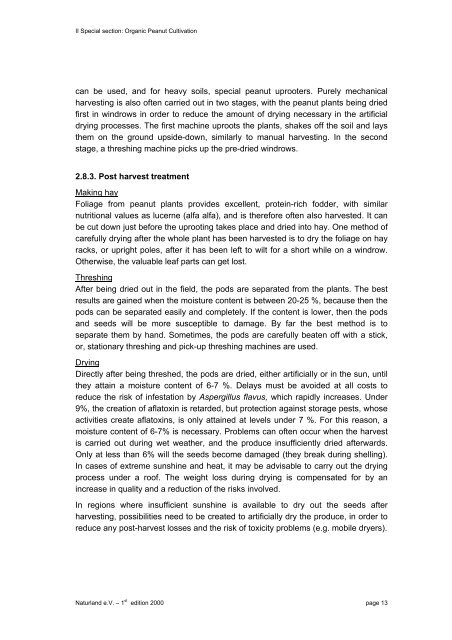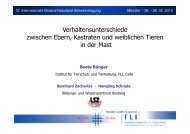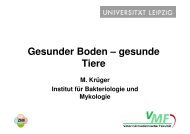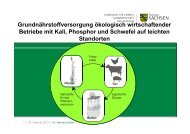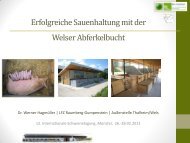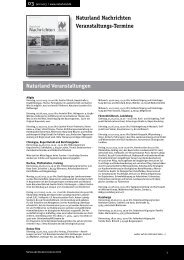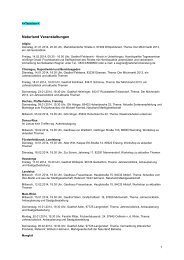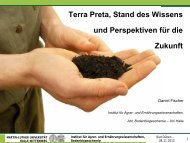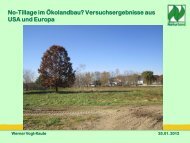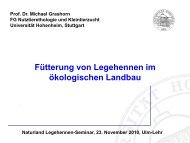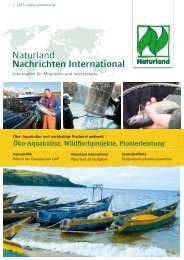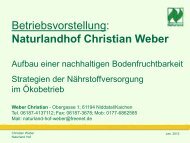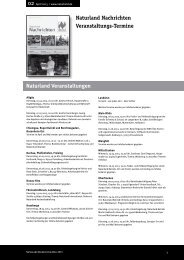Organic Farming in the Tropics and Subtropics: Peanuts - Naturland
Organic Farming in the Tropics and Subtropics: Peanuts - Naturland
Organic Farming in the Tropics and Subtropics: Peanuts - Naturland
You also want an ePaper? Increase the reach of your titles
YUMPU automatically turns print PDFs into web optimized ePapers that Google loves.
II Special section: <strong>Organic</strong> Peanut Cultivation<br />
can be used, <strong>and</strong> for heavy soils, special peanut uprooters. Purely mechanical<br />
harvest<strong>in</strong>g is also often carried out <strong>in</strong> two stages, with <strong>the</strong> peanut plants be<strong>in</strong>g dried<br />
first <strong>in</strong> w<strong>in</strong>drows <strong>in</strong> order to reduce <strong>the</strong> amount of dry<strong>in</strong>g necessary <strong>in</strong> <strong>the</strong> artificial<br />
dry<strong>in</strong>g processes. The first mach<strong>in</strong>e uproots <strong>the</strong> plants, shakes off <strong>the</strong> soil <strong>and</strong> lays<br />
<strong>the</strong>m on <strong>the</strong> ground upside-down, similarly to manual harvest<strong>in</strong>g. In <strong>the</strong> second<br />
stage, a thresh<strong>in</strong>g mach<strong>in</strong>e picks up <strong>the</strong> pre-dried w<strong>in</strong>drows.<br />
2.8.3. Post harvest treatment<br />
Mak<strong>in</strong>g hay<br />
Foliage from peanut plants provides excellent, prote<strong>in</strong>-rich fodder, with similar<br />
nutritional values as lucerne (alfa alfa), <strong>and</strong> is <strong>the</strong>refore often also harvested. It can<br />
be cut down just before <strong>the</strong> uproot<strong>in</strong>g takes place <strong>and</strong> dried <strong>in</strong>to hay. One method of<br />
carefully dry<strong>in</strong>g after <strong>the</strong> whole plant has been harvested is to dry <strong>the</strong> foliage on hay<br />
racks, or upright poles, after it has been left to wilt for a short while on a w<strong>in</strong>drow.<br />
O<strong>the</strong>rwise, <strong>the</strong> valuable leaf parts can get lost.<br />
Thresh<strong>in</strong>g<br />
After be<strong>in</strong>g dried out <strong>in</strong> <strong>the</strong> field, <strong>the</strong> pods are separated from <strong>the</strong> plants. The best<br />
results are ga<strong>in</strong>ed when <strong>the</strong> moisture content is between 20-25 %, because <strong>the</strong>n <strong>the</strong><br />
pods can be separated easily <strong>and</strong> completely. If <strong>the</strong> content is lower, <strong>the</strong>n <strong>the</strong> pods<br />
<strong>and</strong> seeds will be more susceptible to damage. By far <strong>the</strong> best method is to<br />
separate <strong>the</strong>m by h<strong>and</strong>. Sometimes, <strong>the</strong> pods are carefully beaten off with a stick,<br />
or, stationary thresh<strong>in</strong>g <strong>and</strong> pick-up thresh<strong>in</strong>g mach<strong>in</strong>es are used.<br />
Dry<strong>in</strong>g<br />
Directly after be<strong>in</strong>g threshed, <strong>the</strong> pods are dried, ei<strong>the</strong>r artificially or <strong>in</strong> <strong>the</strong> sun, until<br />
<strong>the</strong>y atta<strong>in</strong> a moisture content of 6-7 %. Delays must be avoided at all costs to<br />
reduce <strong>the</strong> risk of <strong>in</strong>festation by Aspergillus flavus, which rapidly <strong>in</strong>creases. Under<br />
9%, <strong>the</strong> creation of aflatox<strong>in</strong> is retarded, but protection aga<strong>in</strong>st storage pests, whose<br />
activities create aflatox<strong>in</strong>s, is only atta<strong>in</strong>ed at levels under 7 %. For this reason, a<br />
moisture content of 6-7% is necessary. Problems can often occur when <strong>the</strong> harvest<br />
is carried out dur<strong>in</strong>g wet wea<strong>the</strong>r, <strong>and</strong> <strong>the</strong> produce <strong>in</strong>sufficiently dried afterwards.<br />
Only at less than 6% will <strong>the</strong> seeds become damaged (<strong>the</strong>y break dur<strong>in</strong>g shell<strong>in</strong>g).<br />
In cases of extreme sunsh<strong>in</strong>e <strong>and</strong> heat, it may be advisable to carry out <strong>the</strong> dry<strong>in</strong>g<br />
process under a roof. The weight loss dur<strong>in</strong>g dry<strong>in</strong>g is compensated for by an<br />
<strong>in</strong>crease <strong>in</strong> quality <strong>and</strong> a reduction of <strong>the</strong> risks <strong>in</strong>volved.<br />
In regions where <strong>in</strong>sufficient sunsh<strong>in</strong>e is available to dry out <strong>the</strong> seeds after<br />
harvest<strong>in</strong>g, possibilities need to be created to artificially dry <strong>the</strong> produce, <strong>in</strong> order to<br />
reduce any post-harvest losses <strong>and</strong> <strong>the</strong> risk of toxicity problems (e.g. mobile dryers).<br />
Naturl<strong>and</strong> e.V. – 1 st edition 2000 page 13


